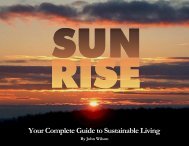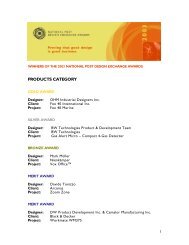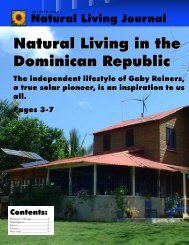Volume 3 - Program & Project Ideas (PDF - 4.5 - Natural Life Network
Volume 3 - Program & Project Ideas (PDF - 4.5 - Natural Life Network
Volume 3 - Program & Project Ideas (PDF - 4.5 - Natural Life Network
Create successful ePaper yourself
Turn your PDF publications into a flip-book with our unique Google optimized e-Paper software.
<strong>Natural</strong> Resources Canada – Community Energy Systems<br />
thermal heating and up to 29,000 tons of chilling. The chilling is provided by a<br />
combination of electrical chilling units, absorption chillers using low pressure steam from<br />
the boilers and, during the shoulder season, free cooling provided directly by water from<br />
the Ottawa River. The mix of chilling equipment enables the plant to optimize its<br />
performance, and has become one of the most cost effective sources of cooling in Ottawa.<br />
For additional information, contact Dan Derousie, Director, Operational Support Services,<br />
PWGSC. Tel.: (819) 775 4040.<br />
A.4 Waste heat recovery<br />
The use of heat recovered from an industrial process to displace the use of fossil fuel<br />
within the community or industrial park.<br />
- Case Study: Burnaby, BC<br />
The solid waste incinerator, operated by Montenay Inc. for the Greater Vancouver<br />
Regional District (GVRD) in Burnaby, has for many years provided medium-pressure<br />
steam for local industries. The plant has since been modified to allow the boilers to<br />
produce high-pressure steam that is then passed through a turbine to generate electricity.<br />
Medium-pressure steam, suitable for the needs of the local industries, is extracted from<br />
the steam turbine. The green electricity is used locally within the GVRD.<br />
For additional information, contact Ron Richter, Monteany Inc. Tel.: (604) 521 1025<br />
- Case study: City of Vancouver and the Corporation of Delta, BC<br />
A landfill gas collection and flare system and co-generation plant at the Burns Bogg<br />
landfill was developed in partnership with Maxim Power Corporation to produce<br />
electricity for local greenhouses and reduce greenhouse gas emissions.<br />
Source: This case study will be highlighted in a document to be issued by the Federation of<br />
Canadian Municipalities. For information, contact the office at 24 Clarence Street, Ottawa,<br />
Ontario K1N 5P3, Tel: (613) 241-5221 ext. 245, fax: (613) 241-7440<br />
A.5 Bioenergy<br />
The use of biological matter (wood, landfill gas, biosolids, combustible refuse) can<br />
provide a regular supply of inexpensive fuel for thermal or electrical power generation.<br />
Bioenergy, like fossil fuels, can produce CO2. However, the net emission of CO2 from<br />
bioenergy will be zero as long as plants are replenished.<br />
Draft 4/11/2005 115






